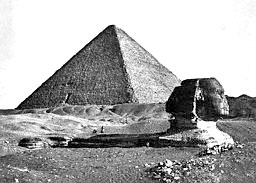|
Chapter Ten
NAVEL OF THE
EARTH
"Twenty four years before the nuclear calamity two paths crossed,
and not by accident. One was that of a god who was certain that his
Fate had become a Destiny; the other was a man whose Destiny became
his Fate. The god was Marduk; the man was Abraham; the place where
their paths crossed was Harran.
"And an outcome of that was to last to our very own times, when
Babylon (now Iraq) rained deathly missiles on the land of
Jerusalem
(now Israel).
Mr. Sitchin recounts at this point facts which he has written in his
Book
The Wars of Gods and Men, of the affairs of
Abraham and Marduk
in that area; he then continues:
"Far from the customary picture painted of
Abram as a nomadic
sheepherder, he turns out to be a superb military leader and a major
actor on the international scene. It can all be explained, we
suggest, only if one accepts the reality of the Anunnaki presence
and takes into consideration the other major events occurring at the
same time. The only prize worth an international war - at the very
time that Nabu was organizing fighters in the lands west of the
Euphrates - was the spaceport in the Sinai. It was that which
Abram
- allied with the Hittites and trained by them in Martial arts - was
hurriedly sent to protect. It was to that purpose that an Egyptian
Pharaoh in Memphis, himself facing an invasion by followers of Ra/Marduk
based in Thebes in the south, provided Abram with a camel-riding
cavalry and a large number of other men and women servants. And it
was because Abram successfully protected the gateway to the spaceport
that Yahweh assured him of a great reward - as well as promised him
protection from future retribution by the losing side.
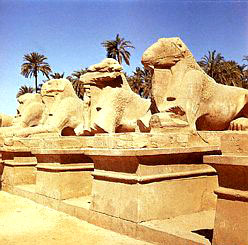 "The War of the Kings took place, by our calculations, in 2041 B.C.
The year after that the princes of the south captured Memphis in
Egypt and dethroned Abram’s ally, declaring allegiance to Amon-Ra,
the "hidden" or "unseen" Ra/Marduk, who was then still in exile.
(After Marduk’s rise to supremacy, the new rulers of Egypt began
building in Karnak, a suburb of the capital Thebes, Egypt’s greatest
temple in honor of Amon-Ra; they lined the majestic avenue leading
to it with ram-headed sphinxes, honoring the god whose age, the Age
of the Ram, had arrived).
After the outcome of the wars and the destruction of the spaceport
in Sinai.... "The War of the Kings took place, by our calculations, in 2041 B.C.
The year after that the princes of the south captured Memphis in
Egypt and dethroned Abram’s ally, declaring allegiance to Amon-Ra,
the "hidden" or "unseen" Ra/Marduk, who was then still in exile.
(After Marduk’s rise to supremacy, the new rulers of Egypt began
building in Karnak, a suburb of the capital Thebes, Egypt’s greatest
temple in honor of Amon-Ra; they lined the majestic avenue leading
to it with ram-headed sphinxes, honoring the god whose age, the Age
of the Ram, had arrived).
After the outcome of the wars and the destruction of the spaceport
in Sinai....
"With the spaceport gone,
Abraham’s mission had come to an end. Now
it was up to God to keep his end of the bargain. He had "cut a
covenant" with Abraham to give him and his descendants as an
everlasting legacy the lands between the Brook of Egypt and the
Euphrates River. And now, through Isaac, the promise had to be kept.
"And there was also the question of what to do with the other space
facilities.
"There were, to be sure, two such facilities in addition to the
spaceport itself. One was the Landing Place, to which Gilgamesh had
set his course. The other was the Mission Control Center - no longer
needed, but still intact; a post-Diluvial "Navel of the Earth,"
serving the same function as the pre-Diluvial "Navel of the Earth"
that Nippur had been.
"To understand the similar functions and consequently similar
layouts, one should compare our sketches of the pre and post-Diluvial
space facilities (such sketches appear on Mr. Sitchin’s Books; sorry
they cannot be reproduced here online).
"....After the Deluge, when humanity was granted the three Regions,
the Anunnaki retained for themselves the Fourth Region - the
Sinai
peninsula. There, in the central plain, the ground was both flat and
hard (perfect tank terrain, as modern armies have concluded), unlike
the mud-buried and water-clogged post-Diluvial plain in
Mesopotamia.
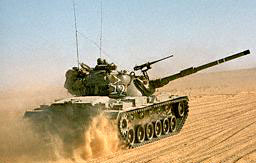 "Choosing again
the twin peaks of Ararat as the anchor point, the
Anunnaki drew a landing path at the same 45º angle to the geographic
parallel - the 30th parallel north. "Choosing again
the twin peaks of Ararat as the anchor point, the
Anunnaki drew a landing path at the same 45º angle to the geographic
parallel - the 30th parallel north.
"There in the central plain of the Sinai peninsula, where the
diagonal line intersected the 30th parallel, was to be the
spaceport. To complete the layout, two more components were
required: To establish a new Mission Control Center, and to
delineate (and anchor) the Landing Corridor.
"We believe that the continuing of the
Landing Corridor preceded the
choosing of the site for Mission Control Center. The reason? The
existence of the Landing Place, in the Cedar Mountains of Lebanon.
"Every folklore, every legend connected with the place repeats the
same assertion, that the place existed before the Flood. As soon the
Anunnaki landed back on Earth after the Deluge on the peaks of
Ararat, they had at their disposal a real, functioning Landing Place
- not a full-fledged spaceport, but a place to land on. All the
Sumerian texts dealing wit the grant to Mankind of "domesticated"
(i.e. genetically altered) plants and animals describe the
biogenetic laboratory in the Cedar Mountains, with Enlil now
cooperating with Enki to restore life on Earth. All the
modern
scientific evidence corroborates that it was from that particular
area that wheat and barley and the first domesticated animals had
come.
(Here again modern advances in genetics join the parade of
corroborations: A study published in the journal Science as recently
as November 1997 pinpoints the place where wild einkorn wheat was
genetically manipulated to create the "Founder Crop" of eight
different cereals: some 11,000 years ago, in that particular corner
of the Near East!)
"There was every reason to include this place - a vast stone
platform of massive construction - in the new space facilities.
That, in turn, determined by equidistant concentric circles the
location of Mission Control Center.
"To complete the space facilities, it was necessary to anchor the
Landing Corridor. In its southeastern end, two nearby peaks - one of
which remained hallowed to this day as the so-called Mount Moses -
were handy. In the equidistant northwestern edge there were no
peaks, just a flat plateau. The Anunnaki - not any mortal Pharaoh -
built there two artificial mountains, the two great pyramids of Giza
(the smaller Third Pyramid, we have suggested in
The Stairway to
Heaven, was built first as a test scale model). The layout was
completed with a "mythological" animal carved from the native rock -
the sphinx. It gazes precisely along the 30th parallel, eastward
toward the spaceport in the Sinai.
"These were the components of the
post-Diluvial spaceport of the
Anunnaki in the Sinai peninsula, as built by them circa 10500 B.C.
And when the landing and takeoff place in the Sinai’s central plain
was blown up, the spaceport’s auxiliary components remained
standing:
"The Landing Place, as we know from the
adventures of Gilgamesh, was
there circa 2900 B.C. Gilgamesh witnessed there, the night before he
had attempted entry, a rocketship rising. The place remained extant
after the Deluge - a Phoenician coin depicted vividly what had stood
atop the stone platform. The vast stone platform still exists. The
place is called
Baalbek - for it was the - "Secret Place of the
North" of the Canaanite god Ba’al. The Bible knew the place as
Beth-Shemesh,
"House/Abode of Shamash" (the Sun God) and it was within the domains
of king Solomon. The Greeks after Alexander called the place
Heliopolis, meaning "City of Helios," the Sun God, and built there
temples of Zeus, his sister Aphrodite, and his son Hermes. The
Romans after them erected temples to Jupiter, Venus, and
Mercury.
The temple of Jupiter was the largest temple ever built by the
Romans
anywhere in the empire, for they believe that the place was the most
important oracle place in the world, one that would foretell the fate
of Rome and its empire.
"....But who could have done that in antiquity? The local legend
says: the Giants. They not only placed those stone blocks where they
are, they also quarried and shaped and carried them over a distance
of almost a mile....
"....Down at the southern end of the
Landing Corridor, the Giza
pyramids still stand, defying all traditional explanations,
challenging Egyptologists to accept that they had been built
millennia before the Pharaohs and not by any one of them. The
Sphinx still gazes precisely eastward along the 30th parallel, keeping to
itself its secrets - perhaps even the secrets of the Book of Thoth.
"And what about Mission Control Center?
"That too exists; it is a place called Jerusalem.
"And there, too, a great and sacred platform rests atop colossal
stone blocks that no man or ancient machine could have moved,
raised, and put in place.
|
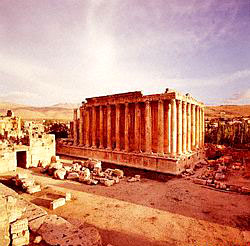 |
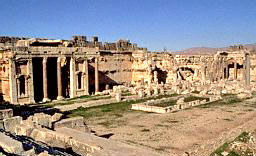
Baalbek
|
"The biblical record of
Abraham’s comings and goings in Canaan
includes two instances of seemingly unnecessary digression; in both
instances, the place digressed to was the site of the future
Jerusalem.
"The first time the digression is reported as an epilogue to the
story of the War of the Kings. Having caught up with and defeated
the invaders all the way north near Damascus, Abraham returned to
Canaan with the captives and the booty....
"....The second seemingly unnecessary digression had to do with the
testing by God of Abraham’s devotion. Abram had already carried out
his mission to Canaan. God had already promised him that his reward
would be great, that God himself would protect him. The miracle of a
son and Legal Heir at extreme old age had happened; Abram’s
name was
changed to Abraham, "Father of multitude of nations."
"....Then all of a sudden, "it was after all those things," the
Bible says (Genesis chapter 22), "that God tested Abraham," telling
him to go to a certain place and there sacrifice his own beloved
son....
"....Abraham, ready to carry out the divine order, found out in the
nick of time that it was only a test of his devotion.... An Angel of
the Lord pointed out to him a ram caught in the bushes, and told him
that it was the ram that was to be sacrificed, not Isaac.... Why go
to the part of Canaan that God identified as the Land of Moriah, and
there to locate a specific mount - which God himself pointed out -
to conduct there the test?
"As in the first instance, there had to be something special about
the chosen place. We read (Genesis 22:4) that "On the third day
Abraham lifted his eyes and saw the place from a distance." The area
was rich, if with anything, with barren mounts; from nearby, and
certainly from a distance, they all look alike. Yet Abraham
recognized the particular mount "from a distance." There had to be
something there that distinguished it from the other mounts. So much
so that when the ordeal was over he gave the place a long remembered
named: The Mount Where Yahweh is Seen. As 2 Chronicles 3:1 makes
clear, Mout Moriah was the Jerusalem
peak on which the Temple was
eventually built.
"From the time Jerusalem became a city, it encompassed three mounts.
Listed from the northeast to the southwest they have been Mount Zophim ("Mount of Observers," now called
mount Scopus in English),
Mount Moriah ("Mount of Directing, of Pointing Out") in the center,
and Mount Zion ("Mount of the Signal"); these are
designations of functions that bring to mind the function-names of the
Beacon Cities
of the Anunnaki marking out Nippur and the
Landing Path when the
spaceport had been in Mesopotamia.
"....Putting lore aside, what we believe
Abraham saw that identified
the mount different, that distinguished it from all others there,
was the great platform upon it.
"A platform which, though smaller than at
Baalbeck’s Landing Place,
was also part of the space facilities of the Anunnaki. For
Jerusalem
(before it came Jerusalem), we suggest, was the post-Diluvial
Mission Control Center.
"And, as at Baalbek, that platform, too, still exists.
"The reason (for the first) and purpose (of the second) digressions
thus come into focus. The fulfillment of his mission was marked by a
formal celebration, including a priestly blessing of Abraham with
the ceremonial bread and wine, at a site - the only site in Canaan -
directly connected to the presence of the Elohim. The second
diversion was meant to test Abraham’s qualifications for a chosen
status after the destruction of the spaceport and the resulting
dismantling of the accoutrements of Mission Control Center; and to
renew there the covenant in the presence of Abraham’s successor,
Isaac. Such a renewal of the divine vow indeed followed right away
after the test....
"....By renewing the divine vow at this particular site, the site
itself - hallowed ground ever since - became part and parcel of the
heritage of Abraham the Hebrew and his descendants.
"The
Divine Promise to Abraham, he had already been told by God, was
to come true only after a passage of time and a servitude in a
foreign land for four hundred years. All told it was a thousand
years later when the descendants of Abraham took possession on the
sacred mount, Mount Moriah. When the Israelites arrived to Canaan
after the Exodus, they found that a tribe of Jebusites had settled
south of the sacred mount, and let them be, for the time to take
possession of that most hallowed ground had not yet come. The
singular prize went to King David, who circa 1000 B.C. - a thousand
years after the testing of Abraham - captured the
Jebusite
settlement and moved the capital from Hebron to what has been
called
in the Bible the City of David.
"It is important to realize that the
Jebusite settlement that David
captured, and his new capital, were not at all "Jerusalem" as it is
now envisioned, not even the walled "Old City." The
area captured by
David and thereafter known as the City of David was on
Mount Zion,
not Mount Moriah. Even when David’s successor Solomon extended the
city northward to a section called Ophel, it still stopped short of
encroaching on the unique area to the north. It indicates, we
suggest, that the sacred platform extending from there northward on
Mount Moriah already existed at the time of David and Solomon.
"The Jebusite settlement was thus not on Mount Moriah and its
platform, but well to its south.
"....One of David’s actions was to transfer the
Ark of the Covenant
from its latest temporary location to the capital, in preparation
for placing it in a proper House of Yahweh which David planned to
erect.... but, the honor, he was told.... would go to his son
Solomon.
"....In the fourth year of his reign - 480 years after the start of
the Exodus, the Bible states - Solomon began the construction of the
Temple, "on Mount Moriah, as had been showed to his father
David...."
"....And the House, when it
was in building, was built of stone made ready before it was
brought thither; so that there was neither hammer nor axe
nor any tool of iron heard in the House while it was in
building."
(I Kings 6:7)
"It took seven years to complete the building of the Temple and to
equip it with all the ritual utensils. Then on the next New Year
("in the seventh month") celebration, the king and the priests and
all the people witnessed the transfer of the Ark of the Covenant to
its permanent place, in the Temple’s Holy of Holies....
"....Biblical data and references, age-old traditions and
archaeological evidence have left no doubt that the Temple that
Solomon built (The First Temple) stood upon the great stone
platform, that still crowns Mount Moriah (also known as the
Holy Mount, Mount of the Lord, or the Temple Mount). Given the
dimensions
of the Temple and the size of the platform, there is general
agreement where the Temple stood, and the Ark of the Covenant within
the Holy of Holies was emplaced upon a rock outcropping, a Sacred
Rock, which according to unwavering traditions was the rock upon
which Abraham was about to sacrifice Isaac.
"....Geologically the rock is an outcropping of the underlying
natural rock, protruding above the level of the stone platform some
five or six feet (the face is not even). But it is a most unusual
"outcropping," in more than one way. Its visible face has been cut
and shaped, with an impressive degree of precision, to form
rectangular, elongated, horizontal and vertical receptacles and
niches of varying depths and sizes. These artificial niches and
receptacles had to have some purpose known to whoever had made those
incisions in the rock. What has been only surmised since long ago
(i.e. Hugo Gressmann, Altorienalische Bilder zum Alten Testament)
has been confirmed by recent researchers (such as Leen Ritmeyer,
Locating the Original Temple Mount): The Ark of the Covenant and the
Walls of the Holy of Holies had been emplaced where the long
straight cut and other niches in the face of the rock were made.
"The implication of those findings is that the cuts and niches in
the face of the rock date back at least to the time of the First
Temple. There is, however, no mention whatsoever in the relevant
passages in the Bible of any such cutting by Solomon; indeed, it
would have been impossible - because the strict prohibition against
the use of metal and other tools on the Mount!
"The enigma of the
Sacred Rock and what had stood on top of it is
magnified by the mystery of what might have stood under it. For the
rock is not a simple outcropping. It is hollow!
"In fact, given permission, one can descend a flight of stairs built
by the Moslem authorities, and end up in a cavelike cavern the rocky
roof of which is the protruding upper part of the Sacred Rock. This
cavern - whether natural or not is uncertain - also features deep
niches and receptacles, both in the rocky walls and (as could be
seen before the floor was covered with prayer rugs) also in the
floor. At one place there is what looks an opening into a dark
tunnel; but what it is and where it leads is a well-kept Moslem
secret.
"....Israeli researchers, fanatically barred from the area, have
determined with the aid of soil-penetrating radar and sonar
technology that there is indeed another major cavity under the
Sacred Rock.
|
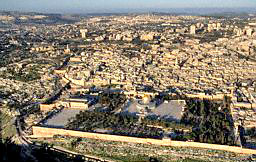
Old City beyond Temple Mount
|
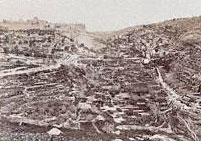
City of David below Temple Mount
.
|
"The Temple Mount is covered by a horizontal stone platform,
slightly off-perfect rectangular in shape (because of the contours
of the terrain), whose size is about 1,600 by 900 feet, for a total
stone-paved area of close to 1,500,000 square feet.
"....The instructions for the
First Temple cover pages upon pages in
the Bible; every small detail is given, measurements are precise to
an amazing degree, where this or that utensil or artifact should be
is prescribed, how long the poles that carry the Ark is specified,
and so on and on. But it all applies to the House of Yahweh.
Not a
word about the platform on which it was to stand; and that could
only mean that the platform has already been there; there was no
need to construct it.
"....Who then built the platform, with all the earthwork and
stonework that it entailed? Our answer, of course, is: the same
master builders who had built the platform at Baalbek (and, for that
matter, the vast and precisely positioned platform on which the
Great Pyramid of Giza stands).
"The great platform that covers the
Temple Mount is surrounded by
walls that serve both as retaining walls and as fortifications. The
Bible reports that Solomon built such walls, as did Judean kings
after him.... Of this walls, only the Western Wall, by tradition and
as confirmed by archaeology, has remained hallowed as an actual
remnant from the time of the First Temple - at least in the lowest
courses where ashlars (perfectly cut and shaped stone blocks) are
the largest. For almost two millennia, since the destruction of the
Second Temple, Jews held on to this remnant, worshipping there,
praying to God, seeking personal succor by inserting slips of paper
with a request to God between the ashlars, bewailing the Temple’s
destruction and the Jewish people’s dispersion - so much so that, in
time, the Crusaders and other conquerors of Jerusalem nicknamed the
Western Wall the "Wailing Wall."
|
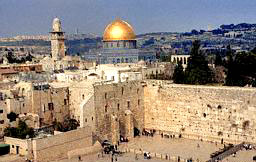 |
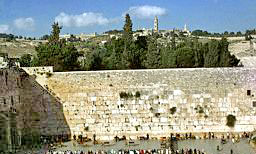
The Western or Wailing Wall
|
"Until the reunification of
Jerusalem by Israel in 1967, the Western
Wall was no more than a sliver of a wall, about a hundred feet or so
squeezed between residential houses. In front was left a narrow
space for the prayers, and on both sides, rising house atop house,
it encroached on the Holy Mount. When the houses were removed, a
large plaza was formed in front of the Western Wall and its
extension all the way to its southern corner was unveiled. And, for
the first time in almost two millennia, it was realized that the
retaining walls extend downward nearly as much as they had been
exposed above what has been consider ground level. As suggested by
the hitherto visible portion of the "Wailing Wall," the lower
courses were larger, better shaped, and of course much older.
|
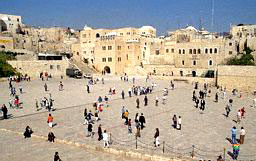
The Large
Plaza in front of the Western Wall |
"Beckoning with mystery and with a promise of ancient secrets was
the extension of the Western Wall to the north.
"There
Captain Charles Wilson explored in the 1860s an archway
(which still bears his name) that led northward to a tunnel-like
passage and westward to a series of arched chambers and vaults. The
removal of the encroaching dwellings revealed that the current
street level lay atop several lower, now-subterranean, levels of
ancient structures that included more passages and archways....
"....Israeli archaeologists concluded that Wilson’s arch was the
entrance way to what must have been in earlier times an open-air
street that ran along the Western Wall, and that the Wall itself
extended northward by hundreds of feet. The laborious clearing of
the rubble, confirming those assumptions, led to the opening in 1996
of the "Archaeological Tunnel" (an event that made headlines for
more than one reason).
"Extending for about 1,600 feet from its start at
Wilson’s Arch to
its exit on Via Dolorosa (where Jesus walked carrying the cross),
the Western Wall Tunnel uncovered and passes through remains of
streets, water tunnels, water pools, archways, structures, and
marketplaces from Byzantine, Roman, Herodian, Hasmonean, and
biblical times. The thrilling and eerie experience of walking
through the tunnel, deep below ground level, is akin to being
transported in a time machine - backward into the past with every
step.
|

Via Dolorosa
|
 |
"....But the greatest surprise, for the visitor as well as for the
archaeologists, lies in the more southerly section of the uncovered
wall:
"There - at the ancient street level but not yet the lowest bottom
course - there have been emplaced massive stone blocks and on top of
them four colossal blocks each weighing hundreds of tons!
Their ton weight is: 600;
570; and 355. Compared with the largest at
the Great Pyramid which is 15 tons!
"These are colossal sizes and weights by any yardstick....
"....Who could have emplaced such colossal stone blocks, and what
for?
"....All the stone blocks used by Solomon, without exception, were
quarried, cut , shaped, and prepared elsewhere to be brought to the
site only for assembly. That this was the case regarding the
colossal stone blocks under discussion is additionally clear from
the fact that they are not part of the native rock; they lie well
above it, and have a somewhat different hue. (In fact the latest
discoveries west of Jerusalem suggest that they might have come from
a quarry there). How they were transported and raised to the
required level and then pushed into the necessary emplacement remain
questions that archaeologists are unable to answer.
"An answer, however, to the question what for? has been offered. The
site’s chief archaeologist, Dan Bahat, writing in Biblical
Archaeology Review, stated:
"We believe that on the other (eastern)
face of the western wall at this point, under the Temple Mount, is
an enormous hall; our theory is that the Master Course" (as this
section had come to be called) "was installed to support and serve
as a counter-force to the vault inside."
"The sections with the enormous stone blocks lies only slightly to
the south of the location of the Sacred Stone. To suggest, as we do,
that this massive section was needed for heavy impacts associated
with the site’s function as a Mission Control Center
with its
equipment installed on and within the Sacred Rock, seems to be the
only explanation after all.
Return
Chapter Eleven
A TIME OF
PROPHECY
"Was the delay in the start of building the
Jerusalem Temple due to
the reason given - David’s shedding of enemy blood in wars and feuds
- or was that just an excuse, obscuring another more profound
reason?
"One finds it odd that as a result of the delay the span of time
that had passed from the renewed covenant with Abraham ( and on that
occasion also with Isaac) on Mount Moriah until the Temple’s
building began was exactly a thousand years. It is odd because the
exile of Marduk had also lasted a thousand years; and that seems to
be more than a chance coincidence.
"The Bible makes it clear that the timing of the Temple’s building
was determined by God himself.
"....The notion that a millennium - a thousand years - signifies
more than a calendrical event, portending apocalyptic events, is
commonly held to have stemmed from a visionary account in the Book
of Revelation chapter 20, in which it was prophesied that the
"Dragon, that old Serpent, which is the
Devil and Satan," shall be
bound for a thousand years, cast into a pit and shut therein for a
thousand years, unable to deceive the nations "till the thousand
years should be fulfilled." It will be then that Gog and Magog shall
be engaged in a world war, the First Resurrection of the dead shall
occur, and Messianic Times will begin.
"Those visionary words, introducing in
Christianity the notion (and
expectation) of an apocalyptic millennium, were written in the first
century A.D. So, although the book names Babylon as the "evil
empire," scholars and theologians assume that this was a code name
for Rome.
"But even so, it is significant that the words in
Revelation echo
the words of the prophet Ezequiel (sixth century B.C.) who had a
vision of the Resurrection of the dead on the Day of the Lord
(chapter 37) and the world war of Gog and Magog (chapters 38, 39);
it shall take place, Ezequiel stated, "at the End of the Years." It
was all, he said, foretold by the prophets of Yahweh in the Olden
Days, "who had then prophesied about the Years."
""The Years" to be fulfilled, the count till the "End of Years." It
was indeed many centuries before Ezequiel’s time that the Bible
offered a clue:
A thousand years,
in thy eyes,
are but as one day that has passed.
"....The Hebrew word for "thousand,"
Eleph, is spelled with the
three letters Aleph ("A"), Lamed ("L") and
Peh ("P" or Ph"), which
can be read as Aleph, meaning the first letter of the
alphabet, and
numerically "1." Added together the three letters have the numerical
value 111 (1+30+80), which can be taken as a triple affirmation on
the Oneness of Yahweh and of monotheism, "One" being a code word for
"God." Not by chance, the same three letters rearranged (P-L-A)
spell Peleh - a wonder of wonders, an epithet for God’s handiwork,
and the Mysteries of Heaven and Earth that are beyond human
understanding. Those wonders of wonders referred principally to the
things created and foretold in the long-ago past; they were also the
subject of Daniel’s enquiry when he sought to Divine the End of Time
(12:6).
"....And as the Bible makes clear, the thousand years whose count
began with the building of the Temple - coinciding with what is now
called the last millennium B.C. - was a time of prophecy.
"To understand the events and prophecies of that last millennium,
one ought to turn the clock back to the preceding millennium, to the
nuclear calamity and the assumption of supremacy by Marduk.
"....The list of fleeing gods (from the
nuclear blasted areas) goes
on and on.... The nuclear cloud shifted southward by the winds,
spared Babylon; and that was taken as an omen reinforcing the grant
of the fifty names to Marduk as an indication of his deserved
supremacy.
"....Scholars have paid a scant attention to the issue of
mathematics in the Bible, leaving untackled what should have been a
puzzle: Why has the Hebrew adopted completely the decimal system,
although Abraham was an Ibri - a Sumerian from
Nippur - and all the
tales in Genesis (as echoed in the Psalms and elsewhere were based
on Sumerian texts? Why was the Sumerian sexagesimal system ("base
60") not at all echoed in the Bible’s numerology - a practice that
culminated in the concept of a millennium?
"One wonders whether
Marduk had been cognizant of this issue. He
marked his assumption of supremacy by proclaiming a New Age (that of
a Ram), by revising the calendar, and by building a new Gateway of
the Gods. In those steps one can find evidence also for a new
mathematics - a tacit shift from the sexagesimal to the decimal
system.
"The focal point of those changes was the temple-ziggurat honoring
him, that Enki suggested be built by the Anunnaki themselves.... it
rose in seven stages, the topmost of which served as the actual
residence of Marduk.... The result (of the ziggurat) was a cube
whose circumference equaled 60 gar in each of its three dimensions,
giving the structure the celestial number 3600 when squared (60 x
60) and 216,000 when cubed (60 x 60 x 60). But in that number was
hidden a shift to the decimal system, for it represented the
zodiacal number 2,160 multiplied by 100.
"The
four corners of the ziggurat faced precisely to the four
cardinal points of the compass. As studies by archaeoastronomers
have shown, the staggered height of each of the six stages was
precisely calculated to enable celestial observations at that
particular geographic location. The ziggurat was thus intended not
only to surpass Enlil’s onetime Ekur, but also to take over
Nippur’s
astronomical/calendrical functions.
"....As in Mesopotamia, so was the calendar revised in Egypt.
Originally revised there by Thoth, whose "secret number" was
52, it
divided the year into 52 weeks of 7 days each, resulting in a solar
year of only 364 days (an issue prominent in the
Book of Enoch). Marduk (as
Ra) instituted instead a year based on a division into
10: he divided the year into 36 "decans" of ten days each: the
resulting 360 days were then followed by five special days, to
complete 365.
"The New Age ushered in by Marduk
was not one of monotheism. Marduk
did not declare himself sole god; indeed, he needed the other
gods
to be present and to hail him as supreme. To that purpose he
provided in the sacred precinct of Babylon shrines, small temples
and residences for all the other principal gods, and invited them to
make their homes therein.
Although Marduk invited several
gods to take residence in the sacred
precinct of Babylon shrines....
"....There is no indication in any of the texts that any accepted
the invitation. In fact, at the time that the royal dynasty that
Marduk had envisioned was finally installed in Babylon circa 1890
B.C., the dispersed gods began to establish their own new domains
all around Mesopotamia.
"Prominent among them was
Elam in the east with Susa (later the
biblical Shushan) as its capital and Ninurta as its "national god."
In the west, a kingdom whose capital was called Mari (from the term
Amurru, the Western One) blossomed out into its own on the western
banks of the Euphrates River; its magnificent palaces were decorated
with murals showing Ishtar investing the king, attesting to the high
standing of that goddess there. In the mountainous Hatti Land, where
the Hittites had already worshipped Enlil’s youngest son
Adad by his
Hittite name Teshub (the Wind/Storm God), a kingdom with imperial
strength and aspiration began to grow. And between the Land of the
Hittites and Babylonia there arose a brand-new kingdom - that of
Assyria.... the national god was named Ashur - the "Seeing One." He
combined the powers and identities of both Enlil and Anu, and his
depiction as a god within a winged circular object dominated
Assyrian monuments.
"And, in distant Africa, there was
Egypt, the Kingdom of the Nile.
But there a chaotic period, called by scholars the Second
Intermediate Period, removed the country from the international
scene until the so-called New Kingdom began circa 1650 B.C.
"....As each nation made the claim that they went on the warpath in
the name and on the orders of their national god, the growing
conflicts might well have represented a struggle between the gods
through human surrogates. A clue that seems to confirm this is the
fact that the theophoric names of Pharaohs of the 18th
dynasty
dropped the prefix or suffix Ra or Amen in favor of
Thoth. The
change, that began with Thothmes I (sometimes rendered as Tuthmosis)
in 1525 B.C., also began the beginning of the oppression of the
Israelites. The reason given by the Pharaoh is enlightening:
Launching military expeditions to Naharin, on the Upper Euphrates,
he feared that the Israelites would become an internal fifth column.
The reason? Naharin was the very area where Harran was located, and
where the people were descendants of the Patriarchal relatives.
"....Under Thothmes III.... Moses was forced to flee after he had
stood up for his people.... Seventeen years later, after repeated
demands and a series of afflictions wrought by Yahweh upon "Egypt
and its gods," the Israelites were let go, and the
Exodus began.
"Two incidents mentioned in the Bible, and a major change in Egypt,
indicate theological repercussions among other peoples as a result
of the miracles and wonders attributed to Yahweh in support of his
Chosen People:
""And when Jethro, the Priest of Midian, the father-in-law of
Moses,
heard of all that God had done for Moses and for his people Israel,"
we read in Genesis chapter 18, he came to the Israelite camp....
and Jethro said: "Now I know that Yahweh is greater than all the
gods"; and he offered sacrifices to Yahweh. The next incident
(described in Numbers chapters 22-24) occurred when the Moabite king
retained the seer Bile’am (also rendered Bala’am) to put a curse on
the advancing Israelites. But "the spirit of God came upon Bilam,"
and in a "divine vision" he saw that the house of Jacob was blessed
by Yahweh, and that his word cannot be countermanded.
"The recognition by a non-Hebrew priest and seer of the powers and
supremacy of Yahweh had an unexpected effect on the Egyptian royal
family. In 1379 B.C. - just as the Israelites were entering Canaan
proper - a new Pharaoh changed his name to Akhenaten - the
Aten being represented by the Winged Disc, moved his capital to a new
place, and began to worship one god. It was a short-lived experiment
to which the priests of Amen-Ra put a quick end . . . Short lived
too, was the concept of a universal peace that accompanied the faith
in a universal God. In 1296 B.C. the Egyptian army, ever thrusting
toward the Harran region, was decisively defeated by the Hittites in
the Battle of Kadesh (in what is now Lebanon).
A series of expansions and unifications with
Marduk still worshipped
as supreme god in a recaptured Babylon by the Assyrians; battles and
invasions followed....
"In Canaan, tired of constantly battling city-kings and princedoms
all around them, the Israelites sent, through the High Priest
Samuel, a request to Yahweh: make us a strong nation,
give us a
king!
|
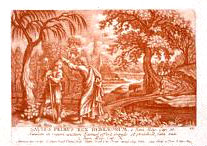
Saul being
anointed by Samuel |
"The first one was
Saul; after him came David, and then the transfer
of the Capital to Jerusalem.
"It was only after the Temple to
Yahweh was built, that prophecy -
the foretelling of things to come - came into full bloom. And there
was nothing akin to the Hebrew Prophets in the Bible, who combined
the preaching of justice and morality with the foreseeing of things
to come, anywhere else in the ancient world.
"The period that is now called in hindsight the first millennium
B.C. was actually the last millennium in the four-thousand-year-old
human story that began with the blossoming out of the Sumerian
civilization. The midpoint in this human drama, whose story we have
called The Earth Chronicles, was the nuclear holocaust, the
demise
of Summer and Akkad, and the hand-over of the Sumerian baton to
Abraham and his seed. That was the watershed after the two thousand
years. Now the next half of the story, the last two millennia of
what had begun in Sumer and a state visit to Earth by
Anu circa 3760
B.C., was also coming to an end.
"That, indeed, was the thread connecting the great biblical
prophecies at that time: The cycle is coming to a closure, what had
been foretold at the Beginning of Years shall be coming true at the
End of Years.
"Mankind has been given an opportunity to
repent, to return to
justice and morality, to recognize that there is only one true God,
the God even of the Elohim themselves. With every word, vision,
symbolic act the Prophets tolled the message: Time is running out;
great events are about to happen. Yahweh does not seek the death of
the evildoers - He seeks their return to righteousness. Man cannot
control his Destiny, but can control his Fate; Man, kings, nations
can choose the course to follow. But if evil shall prevail, if
injustice shall rule human relations, if nation shall continue to
take sword to other nations, all shall be judged and doomed on the
Day of the Lord.
"As the Bible itself acknowledges, it was not a message to a
receptive audience. Surrounded by peoples who seemed to know whom
they worshiped, the Jews were asked to adhere to strict standards
demanded by an unseen God, one whose mere image was unknown.
"....To be believed, the biblical Prophets resorted to miracles -
just as Moses, instructed by God, had to resort to miracles to
obtain the Pharaoh’s release of the Israelites, and then to convince
the Israelites of Yahweh’s almightiness.
"....How believable were those miracles then?
"....While the texts and artifacts discovered by the archaeologists
provided corroboration, they also shed light on profound differences
between the biblical Prophets and those fortunetellers of other
nations. From the very beginning the Hebrew Nebi’im - translated
"prophets" but literally meaning "spokesmen"
of God - explained that
the magic and foresight were not theirs but God’s. The miracles were
His, and what was foretold was just what God had ordained. Moreover,
rather than acting as court employees, as "Yes-men prophets," they
as often as not criticized and admonished the high-and-mighty for
personal wrongdoing or wrong national decisions. Even King David was
reprimanded for coveting the wife of Uriah the Hittite.
"By an odd coincidence - if that is all it was - at the same time
that David captured Jerusalem and took the initial steps to
establish the House of Yahweh on the Sacred Platform, the decline
and decay of what is termed Old Assyria came to an abrupt end and,
under a new dynasty, what historians call the neo-Assyrian period
was ushered in. And no sooner was the Temple of Yahweh built, than
Jerusalem began to attract the attention of distant rulers. As a
direct consequence, its prophets, too, shifted their sights to the
international arena, and embedded prophecies concerning the world at
large within their prophecies regarding Judea, the split-off
northern kingdom of Israel, their kings, and their peoples. It was a
worldview that it was amazing in its scope and understanding - by
Prophets who, before they were summoned by God, were mostly simple
villagers.
"Such profound knowledge of distant lands and nations, the names of
their kings.... their commerce and trade routes, their armies and
makeup of fighting forces, must have amazed even the kings of Judea
at the time.... It was Hanani the Prophet who (warning the
Judean
king against a treaty with the Aramaeans) explained to the king:
Rely on the word of Yahweh, for "it is the eyes of Yahweh that roam
the whole Earth."
"....Assyrian encroachments on the Jewish kingdoms, accurately
recorded in the Bible, began with the northern kingdom, Israel. Here
again, biblical records are fully corroborated by the annals of the
Assyrian kings; Shalmaneser III (858-824 B.C.) even pictured the
Israelite king Jehu bowing down before him, in a scene dominated by
the Winged Disc symbol of Nibiru.... In 722 B.C. the
Assyrian king Shalmaneser V marched on the northern kingdom, captured its capital
Samaria (Shomron - "Little Sumer" - in Hebrew), and exiled its king
and noblemen. Two years later the next Assyrian king, Sargon II
(721-705 B.C.) exiled the rest of the people - giving rise to the
enigma of the Ten Lost Tribes of Israel - and ended the independent
existence of that state.
"....While those calamities, according to the
Bible, befell the
northern state of Israel because its leaders and people failed to
heed the Prophets’ warnings and admonitions, the kings of Judea to
the south were more attentive to the prophetic guidance and, for a
while, enjoyed a period of relative peace. But the Assyrians had
their eye on Jerusalem and its temple; and for reasons which their
annals do not explain, many of their military expeditions started in
the Harran area and then extended westward to the Mediterranean
coast. Significantly, the annals of the Assyrian kings, describing
their conquests and domains in the Harran area, identify by name a
city called Nahor and a city called Laban - cities bearing the names
of the brother and brother-in-law of Abraham.
"....The task of extending the territories and the "command" of the
god Ashur to the House of Yahweh fell to Sennacherib, the son of
Sargon II and his successor in 704 B.C. Aiming to consolidate his
father’s conquest and put an end to recurring rebellions in Assyrian
provinces, he devoted his third campaign (701 B.C.) to the capture
of Judea and Jerusalem.
"The events and
circumstances of that attempt are extensively
recorded both in the Assyrian’s annals and in the Bible, making it
one of the best documented instances of biblical veracity. It was
also an occurrence that showed the veracity of the biblical
prophecy, its value as a foretelling guide, and the scope of its
geopolitical grasp.
"Furthermore, there exists physical evidence - to this very day -
corroborating and illustrating an important aspect of those events;
so that one can see with one’s own eyes how real and true it all
was.
"As we start relating those events with the words of
Sennacherib
himself, let it be noticed that here the campaign against distant
Jerusalem began with a detour to "Hatti Land," to the area of
Harran,
and only then swung all the way westward to the Mediterranean coast,
where the first city attacked was Sidon:
"....In spite of the losses,
Hezekiah remained unyielding - because
the Prophet Isaiah had thus prophesied: Fear not the attacker, for
Yahweh will impose His spirit on him, and he shall hear a rumor, and
will return to his land, and there he will be felled by the sword
....
"Thus sayeth
Yahweh: the king of Assyria shall not enter this
city! The way he came he shall go back, for I protect this city to
save it, for My sake and for the sake of David my servant."
(2 Kings
chapter 19).
"....The boasting (of
Sennacherib in his annals) omits telling what
really happened in Jerusalem; the source for the more complete story
is the Bible. It records, in 2 Kings chapter 20 and, similarly, in
the book of the Prophet Isaiah and in the Book of Chronicles....
After all deals failed for
Sennacherib, the story continues:
"....In a
postscript, the Bible made sure to record that the second
part of the prophesy had also come true (as the first did when all
his men were killed by the Angel of Yahweh in their own camp, and
Sennacherib journeyed back and dwelt in Nineveh).... And it was when
he was bowing down in his temple to his god Nisrock, that Adrameleck
and Sharezzer struck him down with a sword....
"....Only recently did scholars, with the aid of additional
archaeological finds, confirm the biblical account: Sennacherib was
indeed assassinated (in the year 681 B.C.) by two of his own sons,
and the heir to the throne became another, younger son called Esarhaddon.
We, too, can add a
postscript to further confirm the veracity of the
Bible.
"Early in the nineteenth century, archaeologists exploring Jerusalem
discovered that the Tunnel of Hezekiah was fact, not myth: that a
subterranean tunnel indeed served as a conduit for a secret supply
of water in Jerusalem, cut through the city’s native rock under the
defensive walls from the time of the Judean kings! (Sennacherib had
planned to seize the water supplies against Hezekiah, but a tunnel
had been diverted to maintain water supply to Jerusalem, so
Sennacherib’s plan failed)
"....The accuracy and veracity of the biblical account of the events
in Jerusalem extended to the events in faraway Nineveh concerning
the succession on the throne of Assyria: It was indeed a bloody
affair that pitted sons of Sennacherib against him and ended with
the younger son, Esarhaddon (also spelled Asarhaddon), ascending the
throne. The bloody events are described in the Annals of Esarhaddon
(on the artifact known as Prism B), in which he ascribes his choice
of kingship over his older brothers as the result of an oracle given
to Sennacherib by the gods Shamash and Adad - a choice approved by
the great gods of Assyria and Babylon "and all the other gods
residing in heaven and on Earth."
’The bloody end of Sennacherib was but one act in the raging drama
concerning the role and standing of the god Marduk. The Assyrian
attempt to bring Babylonians to heel and in reality annex Babylon by
bringing Marduk over to the Assyrian capital did not work, and
within decades Marduk was returned to his honored position in
Babylon. The texts suggest that a crucial aspect of the god’s
restoration was the need to celebrate the Akitu festival of the New
Year, in which the
Enuma elish was publicly read and the
Resurrection of Marduk was reenacted in a Passion Play, in
Babylon
and nowhere else. By the time of Tiglat-Pileser III, the king’s
legitimacy required his humbling himself before Marduk until Marduk
"took both my hands in his" (in the king’s words).
"To cement his choice of
Esarhaddon as his successor, Sennacherib
had appointed him as Babylon’s viceroy (and named himself "King of Sumer and Akkad"). And when he ascended the throne,
Esarhaddon took
the solemn oath of office: in the presence of the gods of Assyria:
Ashur, Sin, Shamash, Nebo, and Marduk." (Ishtar, though not present,
was invoked in later annals).
"But all those efforts to be religiously inclusive failed to bring
stability or peace. As the seventh century B.C. began, ushering as
the second half of what, counting forward from the Sumerian start,
was the Last Millennium, turmoil seized the great capitals and
spread throughout the ancient world.
"The biblical Prophets saw it all coming; it was the
beginning of
the End, they announced in behalf of Yahweh.
"In the prophesied scenario of events to come,
Jerusalem and its
Sacred Platform were to be the focal point of a global catharsis.
The divine fury was to manifest itself first against the city and
its people, for they had abandoned Yahweh and his commandments. The
kings of the great nations were to be the instruments of Yahweh’s
wrath. But then they, too, each one in his turn, would be judged in
the Day of Judgment. "It will be a judgment of all flesh, for
Yahweh has a quarrel with all the nations," the Prophet
Jeremiah
announced.
"....The sins of nations great and small, from
Egypt and Nubia all
the way to distant China (!) were to be judged on the
Day of Yahweh.
"....Of Egypt the Prophet Isaiah foresaw its occupation by Assyrian
forces after a three-year war. The Prophecy came true at the hands
of Esarhaddon, Sennacherib’s successor. What is remarkable, beside
the prophecy’s fulfillment, is that before leading his army westward
then southward toward Egypt, the Assyrian king made a detour to
Harran!
"That was in 675 B.C. In the same century, the fate of Assyria
itself was sealed. A resurgent Babylon under king Nabupolassar
captured the Assyrian capital Nineveh by breaking the river dams to
flood the city - just as the Prophet Nahum had foretold (1:8). The
year was 612 B.C.
"The remnants of the Assyrian army
retreated - of all places - to
Harran; but there the ultimate instrument of divine
judgment made
its appearance. It would be, Yahweh told Jeremiah (Jeremiah
5:15-16), "a distant nation . . . a nation whose language thou knowest not....
|
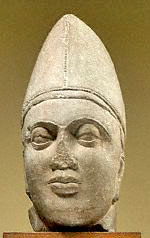
Scythian
Head found in India |
"....The Mesopotamian records of the time speak of the sudden
appearance, from the north, of the Umman-Manda - perhaps advance
forces of Scythians from Central Asia, perhaps forerunners of
the
Medes from the highlands of what is now Iran, perhaps a combination
of both. In 610 B.C. they captured Harran, where the remnants of the
Assyrian army holed up, and gained control of the vital crossroads.
In 605 B.C. an Egyptian army headed by Pharaoh Necho thrust once
again - as Thothmes III had attempted before the Exodus - to reach
and capture Naharin, on the Upper Euphrates. But a combined force of
Babylonian and Umman-Manda, at a crucial battle at
Carcemish near
Harran, gave Egypt’s empire the final coup de grace. It was all as
Jeremiah had prophesied concerning haughty Egypt and its king
Necho....
"Assyria was vanquished - the victor has become a victim. Egyp was
beaten and its gods disgraced. There was no power left to stand in
the way of Babylon - not for Babylon to act out Yahweh’s wrath
against Judea, and then meet her own fate.
"At the helm of
Babylon was now a king of Caesarian ambitions. He
was given the throne in recognition of the victory at Carchemish and
the royal name Nebuchadnezzar (the second), a theophoric name
incorporating the name of Nabu, Marduk’s son and spokesman. He lost
no time launching military campaigns "by the powers of my lords
Nabu
and Marduk." In 597 B.C. he sent his forces to Jerusalem, ostensibly
only to remove its pro-Egyptian king Jeho’iakim and replace him with
his son Jeho’iachin, a mere youth. It was only, it turned out, a
test run; for one way or another, he was fated to play out the role
Yahweh had assigned to him as the punisher of Jerusalem for the sins
of its people, but ultimately, Babylon herself would be judged:
....For a nation from the north hath come upon her
from the north;
it will make her land desolate, without dwellers.
Jeremiah 50:1-3
"It will be an
Earthwide catharsis, in which not only nations but
also their god’s shall be called to account, Yahweh, the "Lord of
Hosts," made clear. But at the end of the catharsis, after the
coming of the Day of the Lord, Zion shall be rebuilt and all the
nations of the world shall gather to worship Yahweh in Jerusalem.
"When all is said and done, the prophet Isaiah declared,
Jerusalem
and its rebuilt Temple would be the sole "Light unto the nations."
Jerusalem shall suffer its Fate, but will arise to fulfill its
Destiny.... Isaiah 2:2-3
"In those unfolding events and prophecies concerning the great
powers, Jerusalem and its Temple, and what is to come in the
Last
Days, the Prophets in the Holy Land were joined by the Prophet
Ezequiel who was shown Divine Visions on the Banks of the Khabur
River in faraway Harran.
"For there, in Harran, the divine and human drama that began when
the paths of Marduk and Abraham crossed, was also destined to come
to an end - at the very same time that Jerusalem and its Temple were
facing Fate.
Return to
'The Cosmic Code'
or
Return to Jehovah
|
 "The War of the Kings took place, by our calculations, in 2041 B.C.
The year after that the princes of the south captured Memphis in
Egypt and dethroned Abram’s ally, declaring allegiance to Amon-Ra,
the "hidden" or "unseen" Ra/Marduk, who was then still in exile.
(After Marduk’s rise to supremacy, the new rulers of Egypt began
building in Karnak, a suburb of the capital Thebes, Egypt’s greatest
temple in honor of Amon-Ra; they lined the majestic avenue leading
to it with ram-headed sphinxes, honoring the god whose age, the Age
of the Ram, had arrived).
After the outcome of the wars and the destruction of the spaceport
in Sinai....
"The War of the Kings took place, by our calculations, in 2041 B.C.
The year after that the princes of the south captured Memphis in
Egypt and dethroned Abram’s ally, declaring allegiance to Amon-Ra,
the "hidden" or "unseen" Ra/Marduk, who was then still in exile.
(After Marduk’s rise to supremacy, the new rulers of Egypt began
building in Karnak, a suburb of the capital Thebes, Egypt’s greatest
temple in honor of Amon-Ra; they lined the majestic avenue leading
to it with ram-headed sphinxes, honoring the god whose age, the Age
of the Ram, had arrived).
After the outcome of the wars and the destruction of the spaceport
in Sinai.... "Choosing again
the twin peaks of Ararat as the anchor point, the
Anunnaki drew a landing path at the same 45º angle to the geographic
parallel - the 30th parallel north.
"Choosing again
the twin peaks of Ararat as the anchor point, the
Anunnaki drew a landing path at the same 45º angle to the geographic
parallel - the 30th parallel north.
